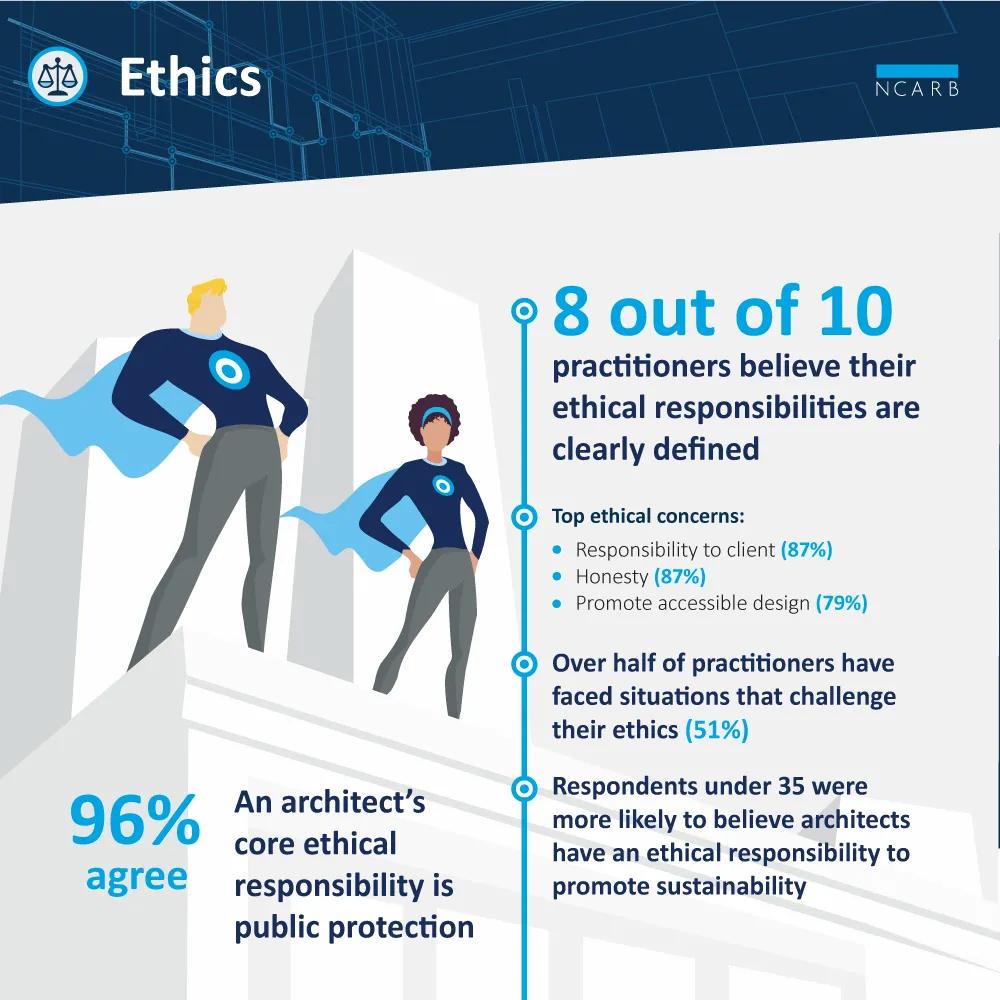As professionals responsible for the public’s health, safety, and welfare, architects are typically held to ethics requirements that govern their professional conduct—but identifying the boundary between ethical responsibilities versus ideal best practices can make it difficult to create a code of conduct. To better understand where architects perceive their responsibilities, NCARB asked thousands of architects, licensure candidates, and students to share their perspectives.

Importance of Ethics
In general, respondents agreed that architects have a responsibility to the public, and that ethical responsibilities were clearly outlined. In addition, respondents indicated that:
- Licensure requirements have a component of ethical responsibility (92%)
- An architect’s ethical responsibilities are outlined by professional organizations more so than by state licensures (70%)
- An architect’s ethical responsibilities exist in perpetuity, long after the project is completed (69%)
Ethical Actions
Respondents were asked to select from a list of actions that architects have a clear ethical responsibility to follow. The top actions that respondents selected were:
- Be responsible to client
- Be honest/have integrity
- Promote accessibility/universal design
- Meet financial responsibilities
- Avoid/disclose conflict of interest
And the actions least selected were:
- Report improper work behavior
- Balance best interest of workplace
- Be responsible to other architects
- Promote carbon advances
- Provide pro bono work
Responding to Ethical Challenges
About half (51%) of respondents indicated that they had encountered situations where their job assignments challenged their ethical responsibilities. For those who had observed these situations, client expectations/demands and value engineering posed the biggest conflict to their ethical responsibility.
The percent of respondents who agreed to the statement: “Are there situations in which your job assignments have challenged your ethical responsibilities?” increase with years since initial licensure and age.
Demographic Differences
There were very slight demographic differences in the ethics section of the Analysis of Practice, with most differences based on years of experience or age.
- Younger respondents were more likely to indicate that promoting carbon advances and sustainability were clear ethical responsibilities
- Younger respondents were also more likely to indicate promoting diversity, equity, and inclusion as a clear ethical responsibility
- Older or more experienced practitioners were more likely to have faced situations that challenged their ethical responsibilities
What’s Next?
Over the coming years, NCARB will continue exploring architects’ ethical responsibilities, especially in light of emerging trends in the profession. Findings from the Analysis of Practice will inform future updates to NCARB’s Model Rules of Conduct. We look forward to sharing more insights from other sections of the Analysis of Practice with you in the months ahead.
About the Analysis of Practice
In 2022, over 19,000 individuals across the architecture, engineering, and construction (AEC) industry participated in NCARB’s once-in-a-decade Analysis of Practice study. Through a series of short questionnaires, focus groups, a final extensive survey, and more, NCARB gathered key insights about the field of architecture that will help shape the licensing model of the future. Results from the study will help us better understand the ecosystem of architectural practice and may lead to changes to NCARB’s national licensing programs and standards of the future.